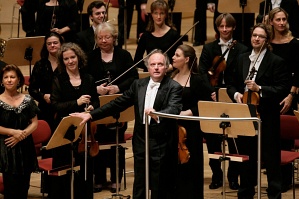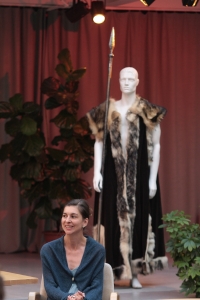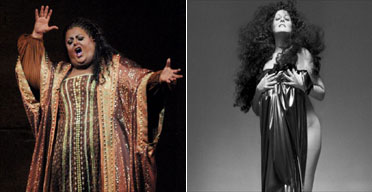 Scruton's essays on Wagner are often difficult to summarize. This is not because they can be complex (although they sometimes are), or because he presupposes some existing detailed knowledge of Wagner (which he often does). No, the truth is that he tends to "ramble", wonder-off from his main point, make multiple detours of questionable value. If ever there was an author that needed an editor it is Scruton (a little like the comments thrown at Wagner, except in Wagner's case they are actually unfounded - most of the time). Of course, this does not make Scruton's essays without value - far from it. And given their occasional founding in magical realism perhaps his rambling narrative is not only understandable but even deliberate - he is trying to explain the unexplainable after all. So, with that in mind let's try to summarize the main "point"(there is more than one) of this essay from 2003:
Scruton's essays on Wagner are often difficult to summarize. This is not because they can be complex (although they sometimes are), or because he presupposes some existing detailed knowledge of Wagner (which he often does). No, the truth is that he tends to "ramble", wonder-off from his main point, make multiple detours of questionable value. If ever there was an author that needed an editor it is Scruton (a little like the comments thrown at Wagner, except in Wagner's case they are actually unfounded - most of the time). Of course, this does not make Scruton's essays without value - far from it. And given their occasional founding in magical realism perhaps his rambling narrative is not only understandable but even deliberate - he is trying to explain the unexplainable after all. So, with that in mind let's try to summarize the main "point"(there is more than one) of this essay from 2003:
1 - Modern opera producers are ruining Wagner productions.
2 - They are doing this because they are striping them of the magical-realism that seems to be at their core
3 - In-turn, they are doing this because they reject religious need - whether this is in the form of gods as real or gods as created by us but still of value
4 - They are thus "domesticating" Wagner and are doing so because, they cannot accept the need for a "religious experience" that Scruton believes is fundamental to us as human beings . A little like rebellious teenagers rejecting their parents and their values.
5 - But he maintains - not unreasonably - that some form of "religious" (or at least spiritual) experience is central to Wagner performances (although this is not religious or spiritual in the orthodox or traditional sense).
With that in mind I present Roger Scruton's essay from Prospect Magazine 2003 although I disagree with him. The "sacred" can be presented in many different ways and in the most mundane situations. and indeed it is often in the "mundane" that it can be found most often. The problem with Scruton's approach is, I believe, that his version of how the "sacred" should be presented or how "religious experience" should take place is fixed and rigid - something that Wagner clearly fought against for all of his career.
Man and superman - Roger Scruton
Wagner searched myths for tales of ancient heroism. But the ideals he found there - of sacrifice, redemption and the sanctity of love - led him back to the modern world
Wagner's mature operas concern heroes who move in a mythic realm and who are prompted by emotions that have been lifted free of ordinary human contingencies and endowed with a cosmic significance and force.
In works like The Ring, Tristan and Parsifal, the human condition is idealised, as it might be in the narratives and liturgy of a religion. To take these operas seriously is to be drawn into a peculiar modern project: that of remaking the gods out of human material. This project, it seems to me, identifies both the artistic triumph of Wagner and the hostility with which that triumph is so often greeted.
Wagner tried to create a new musical public, one that would see the point of idealising the human condition. But with kitsch culture already eclipsing the romantic icon of the artist as priest, his attempt was doomed from the start.

Since then, Wagner's enterprise has acquired its own tragic pathos, as modern producers, embarrassed by dramas that make a mockery of their way of life, in turn make a mockery of the symbolism. Sarcasm and satire run riot, as in Richard Jones's 1994-96 Covent Garden production of The Ring, because nobility has become intolerable.
As Michael Tanner argued in his penetrating defence of the composer, modern productions attempt to "domesticate" Wagner, to bring his works down from the exalted sphere in which the music places them to the world of human trivia, thus cancelling the rich ambiguities of the drama.
Critics of Wagner have approached his art with an antagonism that has few parallels outside the chronicles of religious censorship. Nietzsche led the way, in writings that are penetrating in just the way that religious inquisitions are penetrating. Theodor Adorno tried, in his tortured and tortuous way, to discover corruption in the melodic and harmonic structure of Wagner's music.
Other critics have seen the agitated anti-semitism of the man as sufficient condemnation of the work, without troubling to ask where, and how, the anti-semitism finds endorsement in the music. Even a critic as thoughtful and alert to the musical argument as Barry Millington can write as though anti-semitism were somewhere near the top of Wagner's agenda.
To a great extent, this obsessive distraction from the real questions surrounding Wagner's art and philosophy has been laid to rest by Bryan Magee in Wagner and Philosophy, his account of Wagner's intellectual background. Nevertheless, something needs to be added to Magee's defence if we are to understand the root of the hostility to Wagner.
For much of his life, Wagner was a revolutionary, distinguishing himself in the liberal-socialist cause. But the philosophy that is most easily gleaned from his later works is in sharp conflict with the egalitarian project, and his celebration of the German idea has made him far more useful to nationalists and traditionalists than he could ever be to socialists or liberals. Subsequent history has confirmed the suspicions of left-wing critics, and, as a result, the crimes of Hitler are read back into the operas of Wagner as though they originated in that source.
Wagner did not believe that human beings are equal in any of the respects that make life worthwhile. His art is dedicated to human distinction, and his ideal hero could not be taken as a model by socialists. The dramatic context, meanwhile, makes it all too easy to suppose that the composer's anti-semitism is of a piece with his hero-worship and that both are founded in an ideology of racial supremacy.
Nietzsche was less bothered by the anti-semitism than by the hero-worship. In his view, the heroic in Wagner is a sham. Rather than accept Wagner's characters in the terms suggested by the drama - terms in which Wagner himself, as a disciple of the materialist philosopher Feuerbach, did not believe - we should, Nietzsche advises, translate them "into reality, into the modern... into the bourgeois". What then? We find ourselves among the banal problems of "Parisian decadents".

Nietzsche does not condemn the art by finding fault with the man. He purports to discern a profound artistic failing in the works themselves. Nietzsche is asking us to see through Wagner's characters, with their vast fields of heroic action, to the emotions from which their deeds derive.
What we then find, he believes, is not heroic fortitude, generous love or world-redeeming renunciation, but attention-seeking neurosis and an inability to accept the world as it is. He invites us to see them as one-dimensional people lifted free from the bourgeois reality of cost and benefit, to enjoy a spurious sovereignty over their fate in a fairy-tale world.
But Wagner's dramas are not fairy tales. Nothing in them is more impressive than the grim realism with which wholly intelligible motives are carried through to their crisis. At the same time, these motives are placed in a prehistoric, mythical or medieval setting. Wagner's purpose was to create the kind of distance between audience and drama that would endow the drama with a universal significance. Hence his preoccupation with myths and legends - stories that depart from realism to convey universal truths about the human condition.
When Wagner applied himself to the study of the surviving literature of the early Germanic tribes, and to the poetry of medieval Germany, it was to acquaint himself with a culture in which the real had been penetrated by the ideal. He discovered myth as a distinct category of human thought. Myth dawned on Wagner as a form of social hope. It was a way of thinking that could restore to modern man the lost sense of the ideal.
Wagner's appropriation of myth is not merely a matter of one person's moral and artistic credo. It is also one of the great intellectual advances of modern times: the ancestor and inspiration of comparative anthropology, symbolist poetry, psychoanalysis and many aesthetic and theological doctrines that are now common currency.
Wagner is given credit for this by Claude Lévi-Strauss (who acknowledges the composer as the main inspiration behind his structuralist method), by the anthropologist and medievalist Jessie L Weston and by Weston's disciple, TS Eliot, in The Waste Land. This accumulation of myth-analysing and myth-making makes it necessary to revisit Wagner's approach and to study the vitality with which he transformed ancient myth into modern art.

A myth, for Wagner, is not a fable or a religious doctrine, but a vehicle for human knowledge. Myths are set in a vanished world of chthonic forces and magniloquent deeds. But this obligatory "pastness" is a device: it lifts the story out of the stream of human life and endows it with a timeless meaning.
Wagner's impulse - to discover in the ancient legends of the Germanic people a living record of the time of heroes - led him back to his starting point: the modern world. Myths do not speak of what was but of what is eternally. They are magical-realist summaries of the world, in which the moral possibilities are personified and made flesh.
Hence The Ring, Wagner's synthesis of the Germanic and Icelandic myths, became the most determinedly modern of his works, providing a commentary on modern life, its hopes and fears. Yet planted within the bitter and often cynical drama is the heroic ideal - the ideal that Wagner had searched for as a past reality, but which he discovered to be a myth.
For Wagner, the heroic ideal, enshrined in the love of Siegfried and Brünnhilde, was not refuted but vindicated by its mythical setting. Of course, Wagner did not see the legends that he wove into dramas as we would see them.
But he responded to their hidden fund of religious feeling, and this endows the Wagnerian music dramas with their distinctive spiritual glow. His emendations were designed to reveal the sacred character of our deepest emotions, and to isolate the moments of sacrifice in which ideals become real. We are constantly reminded that love, treated as a summons to sacrifice, is a sacred, redeeming force. All else is compromise.
It is only if we understand the religious nature of Wagner's dramas that we will be able to account for their appeal to modern people, and for the hostility they inspire. For Wagner, as for the Greeks, a myth was not a decorative fairy tale, but the elaboration of a secret, a way of both hiding and revealing mysteries that can be understood only in religious terms, through the ideas of sanctity, holiness and redemption. These are ideas that all of us need, Wagner believed, and, although the common people perceive them through the veil of religious doctrine, they find articulate form in art.

Wagner's works are therefore more than mere dramas: they are revelations, attempts to penetrate to the mysterious core of human existence. They are not unique in this: Aeschylus and Shakespeare (to whom Wagner was indebted) also present dramas that are shaped as religious epiphanies. But Wagner's medium enabled him to present the individual passions of his characters simultaneously with their universal archetypes.
The orchestra does not merely accompany Wagner's singers; it fills in the space beneath the revealed emotions with all the ancestral longings of our species, transforming these individual passions into symbols of a common destiny that can be sensed but not told.
In Parsifal, the moment of sacrifice achieves Christian form. But Christianity is grafted on to a more pagan conception of sacrifice - a conception that comes vividly to mind in the two immolations of Brünnhilde and in the death of Siegfried.
As Siegfried is led forward to the slaughter, he is observed by the orchestra, which follows his narrative in a kind of subdued awe, encouraging him to give the sign of acceptance that will summon the sacrificial blow.
Using his musical technique to bring these undercurrents of religious emotion to the surface, Wagner idealised the passions of his characters, and made it not only plausible but right that they should sacrifice everything for what would otherwise be the transient nothingness of love.
Wagner acquaints us with our lot, and makes available to an age without religious belief the core religious experience. And yet it is the god-haunted, dream-enchanted landscape of The Ring - a setting that creates the context for religious awe - that modern producers hasten to airbrush from the story.
Forests, rivers, dragons and mermaids are re-created in The Ring with a directness that recalls the rich tradition of German literature for children. Looked at in that way, we can see Wagner's Ring cycle as a bridge between two far more humble productions: Grimm's fairy tales and The Lord of the Rings. Grimm influenced Wagner and Wagner made Tolkien possible. Indeed, the emotions that are stirred by the cinematic realisation of Tolkien's rambling story are a faint echo of what would be felt were The Ring to be performed as Wagner intended.
Tolkien's passion for the medieval world arose, like Wagner's, from a lifelong religious quest. Unlike Wagner, however, Tolkien did not have the ability to remake the religious experience through art. His novel has smatterings of the great conflict between good and evil, and an abundance of mysteries. But it does not re-create the experience of the sacred that Wagner has always in mind in the tetralogy.
The Ring abounds in moments of religious awe: Brünnhilde's announcement to Siegmund of his impending death, Sieglinde's blessing of Brünnhilde, Wotan's farewell, Siegfried's first encounter with Brünnhilde, and so on. Virtually all the turning points of the drama are conceived in sacramental terms.
They are occasions of awe, piety and transition, in which a victim is offered and a promise of redemption received. But a Wagnerian twist is given to each of these moments. While the sacred has been interpreted as man's avenue to God, for Wagner it is God's avenue to man. It is the gods, not man, that need redemption, and redemption comes through love.
For Wagner, however, love is possible only between mortals - it is a relation between dying things, who embrace their own death as they yield to it. Brünnhilde recognises this during her great dialogue with Siegmund, in Die Walküre , when she resolves in her heart to relinquish her immortality for the sake of a human love.
But what, on this view, are the gods? Mere figments, as Feuerbach argued? Or something deeply implanted in the scheme of things, something that precedes and survives us? Wagner's answer is not easily explained in words, although it is transparently clear in music. And it is an answer that makes him supremely relevant to us. For, despite our attempts to live without formal religion, we are no more free than people ever have been or ever will be from religious need.
Wagner accepted Feuerbach's view of the gods as human creations. But human creations include some very real and lasting things, like St Paul's Cathedral. Gods come and go; but they last as long as we make room for them, and we make room for them through sacrifice.
The gods come about because we idealise our passions, and we do this not by sentimentalising them but by sacrificing ourselves to the vision on which they depend. It is by accepting the need for sacrifice that we begin to live under divine jurisdiction, surrounded by sacred things, and finding meaning through love. Seeing things that way, we recognise that we are not condemned to mortality but consecrated to it.
Properly produced, the Wagner music-dramas compel their audience to see things in that way - which is why they are no longer properly produced. The sacred prompts the desire for desecration, and, in those who have turned away from religion, this desire is irresistible.
· This is an edited version of an article that appears in the current issue of Prospect magazine.
www.prospect-magazine.co.uk.
This version: Roger Scruton
The Guardian, Saturday 12 April 2003





































